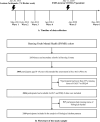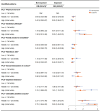Biological rhythm patterns and internalising disorders among children and adolescents: a cross-sectional study
- PMID: 40543910
- PMCID: PMC12182006
- DOI: 10.1136/bmjopen-2024-085703
Biological rhythm patterns and internalising disorders among children and adolescents: a cross-sectional study
Abstract
Objective: To explore the association between biological rhythm and internalising disorders among children and adolescents.
Design, setting and participants: This cross-sectional study used data from the Baoxing Youth Mental Health cohort and included 2119 children and adolescents recruited in December 2021 from 21 primary and secondary schools in Baoxing County, Sichuan Province, China.
Exposure: Biological rhythm was assessed across four domains-eating habits, physical activity, social interactions and sleep behaviours-using a 22-item, self-constructed questionnaire. Principal component analysis was performed to identify the patterns of biological rhythm.
Main outcome measures: The 7-item Generalised Anxiety Disorder scale and the 9-item Patient Health Questionnaire were used to assess internalising disorders. Logistic regression analyses were conducted to examine the association between individual items and patterns of biological rhythm and internalising disorders.
Results: Among the participants, 47.9% were girls and the mean (SD) age was 12.4 (2.69) years. Seven distinct patterns of biological rhythm have been identified. Compared with low adherence level group, a high level of physical exercise (OR 0.43 (95%CI 0.33 to 0.56)), family meals for breakfast (0.53 (0.41 to 0.69)) and nutritious diet (0.48 (0.37 to 0.62)) were associated with a lower risk of internalising disorders. While high level of sedentary lifestyle (2.00 (1.53 to 2.62)), daytime tiredness (2.09 (1.61 to 2.71)) and unhealthy bedtime snacks (3.38 (2.57 to 4.44)) were associated with an increased risk of internalising disorders. Null results were observed for the pattern of social interactions in school (0.89 (0.69 to 1.16)). These associations were maintained for children and adolescents who were exposed to adverse childhood experiences.
Conclusions: The results of this study highlight the potential protective effects of physical exercise, family meals for breakfast and nutritious diet on youth mental health. Well-designed longitudinal studies are needed to further clarify the relationship between patterns of biological rhythm and internalising disorders.
Keywords: Child & adolescent psychiatry; MENTAL HEALTH; NUTRITION & DIETETICS; Physical Fitness; Social Interaction.
© Author(s) (or their employer(s)) 2025. Re-use permitted under CC BY-NC. No commercial re-use. See rights and permissions. Published by BMJ Group.
Conflict of interest statement
Competing interests: None declared.
Figures




References
-
- Adolescent mental health. 2021. https://www.who.int/news-room/fact-sheets/detail/adolescent-mental-health Available.
MeSH terms
LinkOut - more resources
Full Text Sources
Medical
